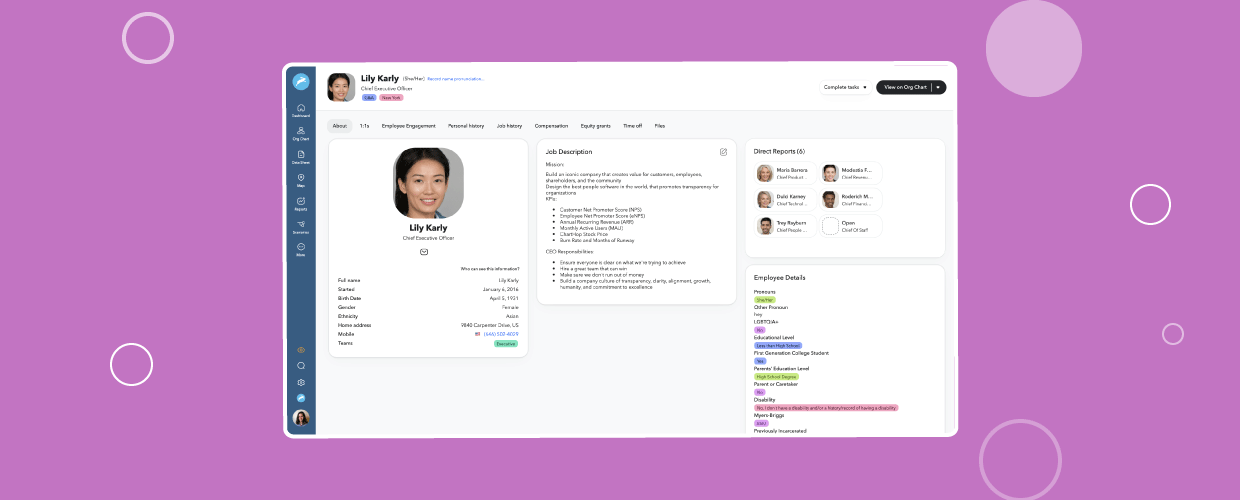Now, arguably more than ever, transparency in the workplace is key to securing business success. With remote-working employees physically disconnected from their teams and managers, organizational transparency is integral in building trust, fostering connection, and boosting performance.
But in the workplace, there’s a fine line between transparency and oversharing. This balance is delicate, and it can be confusing for leaders to determine what information should be shared with the company, and what information (particularly sensitive and confidential business data) might be distracting, or illegal, to disclose.
Balancing transparency with confidentiality might seem intimidating, but believe us: it can be done. As Brene Brown, a psychologist known for her groundbreaking research on vulnerability, recently put it: “Vulnerability minus boundaries is not vulnerability.” In the end, healthy limitations exist to create a culture of trust while ensuring the success of your people and your company.
Read on to find the happy medium between transparency and confidentiality with three helpful tips.
1. Empower your people to find answers on their own
While some information needs to be kept secure or confidential to certain departments, things like company mission, corporate values, organizational goals, org charts, and product roadmaps should be shared with all of your people. They’re a fundamental part of individual and team success.
Especially as people continue to work from home, it’s paramount to be crystal clear about company strategies, goals, and plans. This way, people can better understand their roles and how they play into the bigger picture.
As Ian White, our Founder and CEO, explains, transparency drives comprehension, which drives positive outcomes. “It gives people the context they need to do their jobs,” he said. “When individuals have the information about what they’re trying to accomplish and where the organization is, everyone succeeds.”
What does this look like on the ground? At ChartHop, we use our platform as a self-serve resource that lets people find answers on their own. This includes:
- Company values and goals, so everyone has a reminder of what we do and what we stand for.
- Hiring plans, so people know what’s coming down the pike and how it affects their roles.
- Reporting structure and cross-functional information, so teams know who’s who and what team does what.
- Customized profiles that go beyond names and titles, so people can get to know their colleagues better, even if they’re not physically in the office.
Transparency gives people the context they need to do their jobs. When individuals have the information about what they’re trying to accomplish and where the organization is, everyone succeeds.
Whether it’s via a shared Slack channel, a platform like ChartHop, or a company intranet, empower your people to find the information they need, when they need it.
2. Determine what information drives results, and what’s distracting
Beyond company basics, it can be hard to determine what else to share. While organizational transparency has its benefits, too much transparency can be distracting.
Be strategic about what information you share versus what information you keep secure or accessible to certain people. Otherwise excessive transparency, especially around things like compensation or financials, runs the risk of backfiring.
Take salary bands and compensation, for example. Employees should have clarity on salary bands and how they’re structured. Sharing salary bands alongside your org’s compensation philosophy aligns your employees on how salaries connect to different roles and how they can progress professionally. However, sharing employee’s specific salaries could become distracting and stressful. Especially for people who get paid on commission or have variable salaries, like Sales Reps or Account Managers, access to this information can be counterintuitive.
Other times, confidentiality simply limits what can and cannot be shared. Sensitive data, like financial information, performance reviews, and workplace investigations cannot be disclosed at scale.
Pro Tip: establish boundaries and set expectations with certain departments and individuals on what can and cannot be disclosed.
For example, if your HR department is running a new DEI initiative to improve equity and inclusion, they should share overarching results with the company, as it can inspire accountability and trust. However, specific incidents — like reports of individuals feeling harassed or instances of bias that were disclosed in confidence — cannot be reported with the group. Not only would this foster a culture of distrust, but it could also have serious legal repercussions.
John Renfro, former CHRO of Disney & The Capital Group, recently put it best: “It’s not just about communicating — transparency should drive performance through alignment, drive engagement, drive appropriate development.”
3. Scale your transparency strategy as you grow
Finally, your transparency strategy will change and grow as your company changes and grows.
“The way you’ve operated before is not going to work for the next stage,” explains Beth Clutterbuck, CHRO for Relativity. “That doesn’t mean that guardrails for values around transparency change, but the communication and messages have to adjust as you scale.”
So, maybe as a small start-up, you shared a ton of information with different stakeholders because so many people were involved in the decision-making process. At the enterprise level, that number of people will naturally dwindle. Why? The decision-making process becomes more strategic and, at the highest levels, will typically include executive stakeholders like C-Suite or VPs. In turn, less information is shared. Not because these stakeholders are hiding anything, but because it’s their job to strategize on behalf of the company and only communicate what’s pertinent.
The way you’ve operated before is not going to work for the next stage. That doesn’t mean that guardrails for values around transparency change, but the communication and messages have to adjust as you scale.
Beth Clutterbuck, CHRO @ Relativity
As you grow, take note of how your transparency strategy evolves to find the right balance for your team. Determine:
- What information can be shared and won’t violate any confidentiality rules.
- What information should be shared, versus what might be distracting.
- What information needs to be kept secure to board members, executives, clients, and others.
The Happy Medium Celebrates Clarity and Context
As you shape your transparency strategy, finding that balance between open information-sharing and confidentiality will ebb and flow.
Regardless, it’s vital to prioritize transparency around changes that impact your people, as well as the decision-making behind those processes. There should be no surprises: If compensation & benefit packages are changing, departments are being merged, team members are being promoted, or a product is being launched, your people need to understand how these decisions were made and how it impacts them at work.
For more tips on how to build transparent workplaces, tune in to this webinar recording on SHRM with leaders from ChartHop, Relativity, and Disney.





